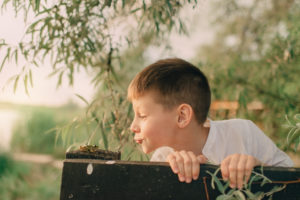Latest Posts
- Have a purpose when backyardingAugust 5 2021
- Study: Time outside alters our microbiomeAugust 4 2021
- Happy National Mutt Day from Mo-MoJuly 27 2021
- New home? Avoid these common mistakes in your yard.July 26 2021
- Infographic: Plan a backyard staycation this summerJuly 22 2021
Categories
Archive
April 13th
5 easy backyard projects for kids

It’s a stressful time as the country seeks to “shelter in place” as much as possible. Getting outside with your family – right in your own backyard – is an important activity, now more than ever. Take your kids outside to de-stress and enjoy the healing benefits of nature in your own little corner of the earth.
Whether you have a big backyard, live in a city, or anything in between, here are 5 easy backyard projects for kids from the TurfMutt Foundation.
- Do a yard survey. The family yard is an outdoor living room, safe space for kids and pets and a great way to destress and relax. Have the whole family go outside and assess your space. What is working well? How would the kids like to use the yard? Then have the kids help with any spring clean-up needed to make your yard the ideal space for your family.
- Go on a backyard nature walk. Connect kids with nature by piquing their natural curiosity. Point out and learn about leaves, budding plants, birds, butterflies, bees and other wildlife right in the backyard.
- Participate in the free, online, do-at-home lesson plans are available from the TurfMutt Foundation. The environmental education program resources, based on STEM (science, technology, engineering and math) principles, teach kids about the benefits of taking care of and spending time in nature. The lessons include outdoor-themed activity sheets for kids in grades K-8 that give children the prompts they need to have fun learning about and exploring the nature and science in their own backyards.
- Plant something. Shrubs, flowers, grass and trees make for a balanced yard, and, if in the city, a container garden helps “green” up the cityscape. Getting your hands dirty also is good for you, says science. The bacterium stimulates serotonin production, which explains why people who spend time gardening, doing yard work, and having direct contact with soil feel more relaxed and happier. Use the USDA Plant Hardiness Zone Map to determine the best types of turf, trees, shrubs, and plants for your climate zone.
- Design a pollinator garden. Plant a butterfly bush and other flowering plants to teach kids about the importance of pollinators—birds, bees and butterflies. Use the Audubon Society’s database to help determine which birds will be attracted to which plants for unique regions so good choices about what to plant can be made.
Learn more by visiting TurfMutt.com.





